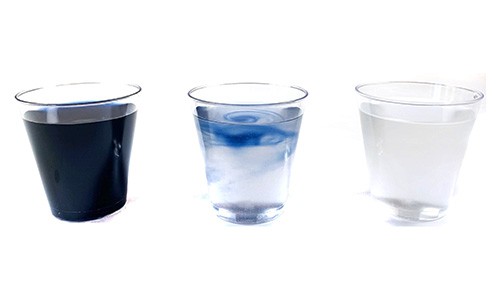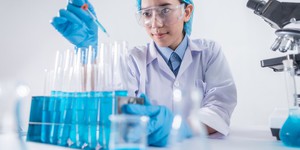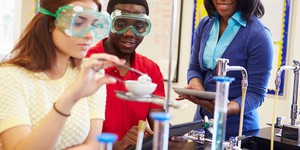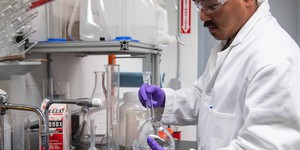Abstract
The iodine clock reaction is a favorite demonstration reaction in chemistry classes that usually requires toxic or hazardous chemicals. During the reaction, two clear liquids are mixed, resulting in another clear liquid. After some time, the solution suddenly turns dark blue. The reaction is called a clock reaction because the amount of time that elapses before the solution turns blue depends on the concentrations of the starting chemicals. In this green chemistry project, you will use a modified iodine clock reaction that uses safe household chemicals to explore factors that affect the rate of the iodine clock reaction.Summary
Svenja Lohner, PhD, Science Buddies
Objective
Determine how the concentration of hydrogen peroxide affects the rate of the iodine clock reaction and determine the reaction order.
Introduction
Chemical kinetics is the branch of chemistry that is concerned with the mechanisms and rates of chemical reactions. The mechanism of a chemical reaction is a description of what happens to each molecule at a very detailed level—which bonds are broken, which new bonds are formed, and how the three-dimensional shapes of the chemicals change during the course of the reaction. The rate of the reaction is a measure of its speed. The rate of a chemical reaction can be measured by how quickly the reactants disappear, or by how quickly the products are generated. The iodine clock reaction is a favorite demonstration in chemistry classes because it has an element of drama. Two clear solutions are mixed, producing a new clear solution. Then, after a period of several seconds, the solution turns dark blue. In a variation of the iodine clock reaction called the Old Nassau reaction, a third solution is added to the mixture which results in the solution first turning orange and then dark blue. A demonstration of both reactions is shown in the two videos below.
Iodine clock reaction:As mentioned, chemical kinetics measures how fast a reaction is occurring. For most chemical reactions, the rate is so fast that special equipment is needed to measure it. For the iodine clock reaction, on the other hand, the rate can be easily measured by monitoring the color change of the reaction. There are many variations of the iodine clock reaction. Each variation uses a different mixture of chemicals. The two key reactants, however, are iodine species (iodide ion, free iodine, or iodate ion), and an oxidizing or reducing reagent (redox agent) in the presence of starch. In this chemistry project, you will use a 'green' version of the iodine clock reaction. What does this mean? It does not mean that the reaction solution turns green instead of dark blue. It means that you will apply green chemistry principles while performing your iodine clock reaction.
The goal of green chemistry (also called sustainable chemistry) is to make chemical reactions and products using environmentally friendly methods. There are twelve principles of green chemistry that help scientists do that. One important one that you will apply in this project is to reduce or eliminate the use and creation of toxic chemicals. In the iodine clock reaction that you will perform in this project, you will be replacing hazardous and toxic chemicals with much safer starting materials. By doing that you will avoid the creation of toxic waste and also prevent environmental pollution.
So, what are the chemicals that you will use in your iodine clock reaction? Your starting materials will be iodine tincture (a mixture of iodine and sodium iodide) or providone-iodine solution, vitamin C (ascorbic acid), hydrogen peroxide, purified or distilled water, and starch. You might notice that these are all common household materials that are relatively safe to use. You will still need to wear personal protection such as goggles and gloves though as some of these chemicals can stain or irritate your skin! This means they are not completely hazard-free, but they are much safer than chemicals used in other variations of the iodine clock reaction. The chemicals they replace include strong acids like hydrochloric acid or sulfuric acid, redox agents such as sodium thiosulfate, sodium bisulfite, persulfate, or chlorate, and other iodine species such as potassium iodate. The above-mentioned Old Nassau reaction, which turns orange before turning dark blue, even uses mercury(II)chloride which is highly toxic!
Due to the different chemicals involved, the reaction mechanism for each version of the iodine clock reaction is different. However, all of the reactions rely on the formation of a triiodide-starch complex. The reactions that form the basis for the green chemistry version of the iodine clock reaction are shown below.
Equation 1:
- H2O2 = Hydrogen peroxide
- I- = Iodide ion (from iodine tincture or providone-iodine solution)
- H+ = A proton, from ascorbic acid (viramin C)
- I3- = Triiodide
- H2O = Water
This equation states that hydrogen peroxide reacts with iodide ions in acid solution to form triiodide and water.
Triiodide has the very interesting property of reacting with starch to form a dark blue triiodide-starch complex. There is starch in the mix of chemicals, so why does the triiodide not react with it? The reason the triiodide does not react with the starch is that it is immediately consumed in a competing reaction with vitamin C (ascorbic acid).
Equation 2:
- I3 = Triiodide
- C6H8O6 = Ascorbic acid (vitamin C)
- H+ = A proton, from ascorbic acid (viramin C)
- 3 I- = Iodide ion
- C6H6O6 = Dehydroascorbic acid (oxidized form of ascorbic acid)
Equation 2 says that triiodide reacts with vitamin C (ascorbic acid) to form iodide ions and dehydroascorbic acid.
The reaction in Equation 2 happens so fast that none of the triiodide has time to form a complex with starch, even though the starch is in the reaction mix. The reactions in Equations 1 and 2 are moving along during the lag time between mixing the chemicals and the dramatic appearance of the blue color. Note that iodide ions are regenerated in Equation 2, so they are available to react with the hydrogen peroxide in Equation 1. Vitamin C, on the other hand, is consumed as it is turned into dehydroascorbic acid. The lag period ends when the vitamin C is all used up. At this time, the triiodide is able to react with the starch.
Equation 3:
- I3- = Triiodide
- I3- starch complex, which is blue
This equation says that starch reacts with triiodide to form a blue triiodide-starch complex.
Looking at all of these equations, we can see that the faster the reaction in Equation 2 goes, the faster the triiodide uses up the vitamin C and the faster the triiodide is free to react with the starch. So, what is the rate of the first reaction? The rate of the reaction in Equation 1 is a measure of how the concentration of hydrogen peroxide changes per unit time:
Equation 4:
- (H2O2) = Concentration of hydrogen peroxide
Equation 4 indicates that the rate of the reaction is proportional to the reciprocal of the time.
The rate of a reaction depends on the concentration of the reactants. In Equation 1, for example, increasing the amount of hydrogen peroxide will increase the rate at which it reacts with iodide. The concentrations of iodide and acid remain the same, so the rate will depend only on the changes in hydrogen peroxide concentration. (The iodide is recycled between Equations 1 and 2, and the concentration of acid is high enough that the change in its concentration is small. Note that an excess of vitamin C is added to the reaction). The rate actually depends on the concentration of hydrogen peroxide raised to a power, called the reaction order.
Equation 5:
- k = Rate constant, in 1/seconds (s)
- (H2O2) = Concentration of hydrogen peroxide, in moles/liter
- x = Order of the reaction for hydrogen peroxide, unitless
In this green chemistry project, you will investigate what the reaction order is for the iodine clock reaction. The good news from Equation 5 is that the rate depends on the concentration of hydrogen peroxide, and you will know what the concentration of hydrogen peroxide is when the reaction starts. You will vary the amount of hydrogen peroxide to see how this affects the time the mixed chemicals stay clear before turning blue. By measuring the time it takes for the reaction mix to turn blue using a stopwatch, you will be able to determine how the hydrogen peroxide concentration changes the reaction rate. You can then use your results to determine the reaction order.
This is not the only way of exploring the chemistry of the iodine clock reaction! The details of the reaction mechanisms can be studied by varying the concentrations of other reactants, in addition to hydrogen peroxide, too. And it is ideal for investigating the effect of temperature on reaction rates. Some of these areas are touched on in the Variations. Now, let's get started.
Terms and Concepts
- Chemical kinetics
- Chemical reaction
- Mechanism
- Rate
- Reactant
- Product
- Iodine clock reaction
- Solution
- Old Nassau reaction
- Redox agent
- Green chemistry
- Sustainable chemistry
- Iodine tincture
- Providone-iodine solution
- Ascorbic acid (vitamin C)
- Hydrogen peroxide
- Distilled water
- Starch
- Triiodide-starch complex
- Reaction order
Questions
- What would happen to the iodine clock reaction if the reaction shown in Equation 2 were very slow instead of very fast?
- What is the acid that is used in the reactions described above?
- Based on your research, what is a chemical complex?
- What is the structure of the starch and triiodide complex? Why is it blue?
- Why does the rate of Equation 2 depend on the rate of Equation 1?
- How would adding more vitamin C (ascorbic acid) affect the lag period of the clock reaction?
- Some sources state that triiodide is not really the form of iodine in the starch complex. What other forms have been proposed and which way does the evidence point (triiodide or not) in your opinion?
- How can Equations 4 and 5 be combined? Hint: The result should show that the reciprocal of the time is proportional to the hydrogen peroxide concentration raised to the value of x, the rate constant.
- What are the 12 principles of green chemistry?
Bibliography
- Wikipedia Contributors. (2009, September 28). Iodine clock reaction. Wikipedia: The Free Encyclopedia. Retrieved October 30, 2009.
- Department of Chemistry, The University of North Carolina at Chapel Hill. (2008). Kinetics. Retrieved October 30, 2009.
- American Chemical Society. (n.d.). 12 Principles of Green Chemistry. Retrieved April 11, 2022.
Materials and Equipment
- 1000 mg vitamin C tablets; available at grocery stores. If possible avoid the chewable tablets.
- Iodine tincture (2%); available at pharmacies. Alternatively, 10% providone-iodine solution can be used.
- Distilled or purified water; available at grocery stores
- Cornstarch
- Hydrogen peroxide (3%); available at grocery stores
- Newspaper to protect work area
- Chemical splash safety goggles; available at Carolina
- Disposable gloves. If you are allergic to latex, use vinyl or polyethylene gloves.
- Measuring cup
- Glasses or cups (2)
- Microwave or stove top
- Spoon
- Mini cups, 2 oz. (2)
- 3 mL graduated pipettes (6); available at Amazon
- Stopwatch or timer
- A white sheet of paper
- Permanent marker
- Lab notebook
Disclaimer: Science Buddies participates in affiliate programs with Home Science Tools, Amazon.com, Carolina Biological, and Jameco Electronics. Proceeds from the affiliate programs help support Science Buddies, a 501(c)(3) public charity, and keep our resources free for everyone. Our top priority is student learning. If you have any comments (positive or negative) related to purchases you've made for science projects from recommendations on our site, please let us know. Write to us at scibuddy@sciencebuddies.org.
Experimental Procedure
Performing the Experiment
- Be sure to wear your safety goggles and latex gloves.
- Protect the surface on which you are working with newspaper.
- Prepare your vitamin C solution.
- Label one of the glasses or cups with "vitamin C solution."
- Measure out 100 mL of distilled or purified water and add it to the labeled cup.
- Fold the white sheet of paper in the middle and place one 1000 mg vitamin C tablet in between the folds.
- Use the spoon to crush the vitamin C tablet.
- Add the crushed vitamin C tablet to the 100 mL water in the cup and stir the solution with the spoon.
- Place the vitamin C solution in the microwave for 30 seconds and stir it again. The crushed vitamin C tablet will not fully dissolve. The solution might still look a bit turbid, but that is ok.
- Prepare your starch solution.
- Label the second glass or cup with "starch solution."
- Measure out 100 mL of distilled or purified water and add it to the labeled cup.
- Add 1/4 teaspoon of cornstarch to the water in the cup and stir the mixture with a clean spoon.
- Place the starch solution in the microwave for 1 minute and stir it again. The solution should be close to boiling. The cornstarch will not fully dissolve. The solution might still look a bit turbid, but that is ok.
- Start the iodine clock reaction (beginning with reaction 1) by adding the vitamin C solution, the idonine tincture, starch solution, and distilled water to the mini cup using a fresh pipette for each chemical. The volumes of each reactant are given in Table 1 below.
- First, add the vitamin C solution to the mini cup. Then add the iodine tincture. Swirl the cup or mix both solutions with a clean pipette until the mixture is colorless. Then continue adding the starch solution and the water. The final solution should be colorless.
- Note: If you are using a 10% providone-iodine solution instead of the 2% iodine tincture, you will have to add 2 mL of 10% providone-iodine solution and 0.5 mL less distilled water to the reaction mix. All the other quantities will stay the same. The total reaction volume should be 30 milliliters.
| Chemical | Reaction 1 | Reaction 2 | Reaction 3 | Reaction 4 | Reaction 5 | Reaction 6 | Reaction 7 | Reaction 8 |
|---|---|---|---|---|---|---|---|---|
| Vitamin C solution | 2.5 mL | 2.5 mL | 2.5 mL | 2.5 mL | 2.5 mL | 2.5 mL | 2.5 mL | 2.5 mL |
| Iodine tincture (2%) | 1.5 mL | 1.5 mL | 1.5 mL | 1.5 mL | 1.5 mL | 1.5 mL | 1.5 mL | 1.5 mL |
| Starch solution | 3 mL | 3 mL | 3 mL | 3 mL | 3 mL | 3 mL | 3 mL | 3 mL |
| Distilled Water (H2O) | 15 mL | 16 mL | 17 mL | 18 mL | 19 mL | 20 mL | 21 mL | 22 mL |
| Hydrogen peroxide (H2O2) | 8 mL | 7 mL | 6 mL | 5 mL | 4 mL | 3 mL | 2 mL | 1 mL |
- Use a clean pipette to briefly mix the chemicals. The solution should be clear as shown in Figure 1.
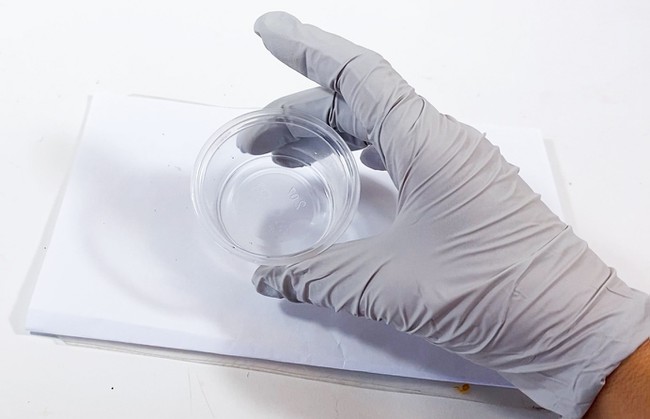 Image Credit: Svenja Lohner, Science Buddies / Science Buddies
Image Credit: Svenja Lohner, Science Buddies / Science Buddies
Figure 1. Mixing all the reactants (except hydrogen peroxide) results in a clear solution.
- Place the mini cup on the folded white sheet of paper to make the color change more visible.
- Label a separate mini cup with "H2O2". Then use a fresh pipette to add the respective volume of hydrogen peroxide for your reaction to the labeled mini cup.
- Add all the hydrogen peroxide from the mini cup at once to the mini cup with the preapred reaction mixture and start your stopwatch as soon as the hydrogen peroxide is added.
- Stir the solution with a clean pipette while waiting for the color change to happen. Good mixing is important! The better mixed your chemicals are, the more dramatic and sudden will be your color change.
- Look at the solution against a white background and stop the stopwatch once you can first see some blue color developing. Note: The color change, especially at the lower H2O2 concentrations, might not be sudden but can take more than a second. If you are using a 10% providone-iodine solution instead of the 2% iodine tincture, the mixture will first turn yellow/orange and then dark blue. Decide at which color you stop your stopwach and keep this the same for all reactions. If your color change happens slowly, try to better mix your reaction solutions in the mini cup. It also takes considerably longer for the color change to happen when you use the 10% providone-iodine solution instead of the 2% iodine tincture. Be patient and prepared to stir the solution for up to 15 minutes.
- Record your measured time (the reaction time) in your lab notebook.
- Carefully pour the dark blue reaction solution down the sink with plenty of cold running water to wash it down. Be careful with this solution, as it contains iodine and will stain surfaces with which it comes in contact.
- Repeat steps 5–13 two more times with the same hydrogen peroxide concentration to make sure you get reproducible results. Keep the temperature the same for each reaction as temperature also affects the reaction time.
- Once you have finished reaction 1, start varying the hydrogen peroxide concentration. Repeat steps 5–14 and change the hydrogen concentration according to Table 1 until you have tried all eight reactions. Remember, each time, you decrease the amount of hydrogen peroxide, you have to increase the amount of water respectively. This will keep the total volume of the reaction constant, while changing the concentration of the hydrogen peroxide.
Analyzing Your Results
- Use your data to make a data table that shows the following:
- The amount of added hydrogen peroxide, in mL.
- The determined reaction time (or time lag) for each test, in seconds (s).
- The average of the reaction times calculated from your three repeated trials for the same H2O2 concentration. For example, average the three trials for the reaction with 3 mL of hydrogen peroxide.
- The reciprocal of the average reaction time for each test, in 1/s.
-
Graph the amount of hydrogen peroxide (in mL) on the x-axis and the reciprocal of the time lag on the y-axis.
- The reciprocal of the time lag is proportional to the rate, so the y-axis is a measure of the reaction rate.
- Label the y-axis Reaction rate and the x-axis Amount of hydrogen peroxide.
-
Note the shape of the curve. From Equation 5 in the Introduction, the curve shape depends on "x," the order of the reaction for hydrogen peroxide.
- If x = 1, the curve will be a straight line. (Doubling the hydrogen peroxide will double the reaction rate).
- If x = 2, the curve will look like the curve for y = x2, which is a parabola (doubling the hydrogen peroxide will make the reaction go four times faster).
- Based on your results, what is the order of the reaction for hydrogen peroxide?
Ask an Expert
Global Connections
The United Nations Sustainable Development Goals (UNSDGs) are a blueprint to achieve a better and more sustainable future for all.
Variations
- Graph the amount of hydrogen peroxide (in mL) on the x-axis and the time lag on the y-axis. What does this graph show?
- Calculate the concentration of hydrogen peroxide for each sample and use this number in your analysis.
- Vary the concentration of other reagents, such as the iodine tincture or vitamin C. Predict how the changes will affect the rate then design a procedure to test your hypothesis.
- Devise a procedure to test how the reaction rate changes with temperature.
- Use a graphing program to determine the value of "x" in your graph of the rate versus hydrogen peroxide concentration.
Careers
If you like this project, you might enjoy exploring these related careers:
Related Links
- Science Fair Project Guide
- Other Ideas Like This
- Chemistry Project Ideas
- Green Chemistry Project Ideas
- My Favorites
- Chemistry Safety Guide
- Chemistry Lab Techniques



